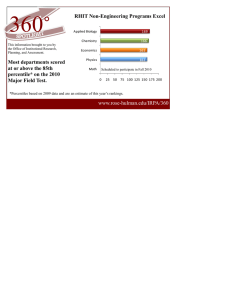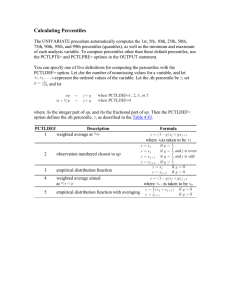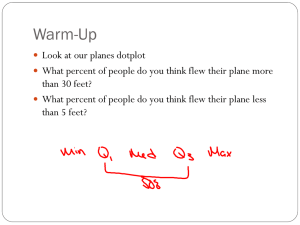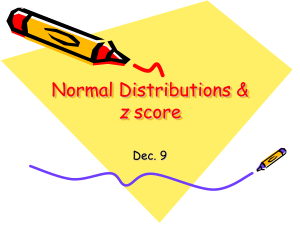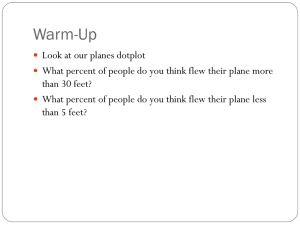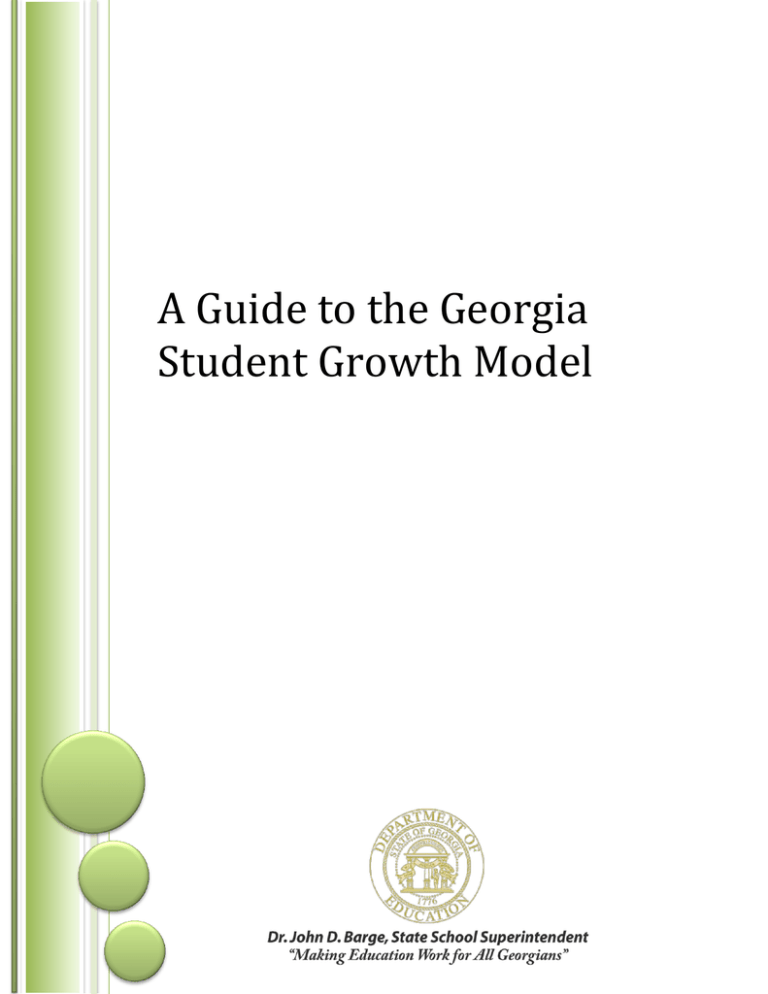
A Guide to the Georgia
Student Growth Model
Table of Contents
Introduction ................................................................................................................................. 2
Growth vs. Value-Added ............................................................................................................ 2
Student Growth Percentiles......................................................................................................... 2
Understanding Percentiles .......................................................................................................... 4
Aggregating or Summarizing Growth Percentiles ...................................................................... 5
Interpreting Student Growth Percentiles ..................................................................................... 5
Calculating Student Growth Percentiles ..................................................................................... 6
Academic Peers ........................................................................................................................... 6
Priors ........................................................................................................................................... 8
Assessment Inclusion .................................................................................................................. 8
Retests ......................................................................................................................................... 9
Missing Data ............................................................................................................................... 9
Growth Over Time (Baseline-Referenced Growth Percentiles) ................................................. 9
Growth to Proficiency (Growth Projections and Growth Targets) ........................................... 11
Accessing Data.......................................................................................................................... 12
Georgia Department of Education
Dr. John D. Barge, State School Superintendent
December 2013 • Page 1 of 12
All Rights Reserved
A Guide to the Georgia Student Growth Model
Introduction
The Georgia Department of Education (GaDOE) is implementing the Georgia Student Growth
Model (GSGM) in order to provide an additional perspective of student learning, improve
teaching and learning, and inform accountability and educator effectiveness. Historically,
Georgia’s assessment system has only enabled educators and other stakeholders to ask questions
such as, “What percentage of students met the state standard?” Or, “Did more students meet the
state standard this year compared to last year?” The GSGM will allow Georgia to move beyond
questions about status to ask critical growth-related questions such as:
Did this student grow more or less than academically-similar students?
Are students growing as much in math as in reading?
Are students on track to reach or exceed proficiency?
The GSGM will provide a wealth of rich information on student, school, district, and state
performance on Criterion-Referenced Competency Tests (CRCTs) and End of Course Tests
(EOCTs). In addition to providing student-level diagnostic information and improving teaching
and learning, the GSGM will work in conjunction with other factors as part of the state’s new
accountability system, the College and Career Readiness Performance Index (CCRPI), and serve
as one of multiple indicators of educator effectiveness with the Teacher Keys Effectiveness
System (TKES) and the Leader Keys Effectiveness System (LKES).
Growth vs. Value-Added
A growth model describes the change in student achievement across time. A growth model
becomes value-added when the growth is attributed to an entity (a teacher, a school, etc.). In
many models, the value-added is the difference between predicted student performance and
actual student performance. These models use information about a student (prior achievement,
demographic information, etc.) to predict how that student will perform. The student’s actual
performance is then compared to his or her predicted performance. The difference is considered
value-added. The GSGM does not predict performance; rather, it describes observed student
growth.
Student Growth Percentiles
Georgia is implementing the Student Growth Percentile (SGP) methodology as its growth model.
SGPs describe a student’s growth relative to other statewide with similar prior achievement
(students who have a similar score history). An SGP not only shows how an individual student is
progressing from year to year, but it can also describe how groups of students, schools, districts,
and the state are progressing. Growth percentiles range from 1 to 99, with lower percentiles
indicating lower academic growth and higher percentiles indicating higher academic growth.
Students also receive growth projections and growth targets, which describe the amount of
growth needed to reach or exceed proficiency in subsequent years.
Georgia Department of Education
Dr. John D. Barge, State School Superintendent
December 2013 • Page 2 of 12
All Rights Reserved
SGPs do not require a vertical assessment scale in order to describe student growth. A vertical or
developmental scale is a continuous scale spanning multiple grade levels in the same content
area. The GSGM is not specifying how many scale score points a student improved from year to
year. Rather, the GSGM describes growth in terms of how a student performed this year relative
to other students who have a similar academic history.
A common concern with growth and value-added models is the potential for what has been
termed “floor or ceiling effects.” Floor and ceiling effects refer to the inability to adequately
define or distinguish really low and really high student growth. Analyses reveal that Georgia
does not have such effects with the GSGM. Figure 1 demonstrates this lack of floor and ceiling
effects using actual GSGM results.
Figure 1: Growth and Prior Achievement
Figure 1 plots current growth for 5th-grade mathematics students (2012) on the x-axis against
these students’ 4th-grade mathematics scale scores from the prior year on the y-axis (2011). As
the figure demonstrates, all students, regardless of their achievement level, are able to
demonstrate all levels of growth.
Georgia Department of Education
Dr. John D. Barge, State School Superintendent
December 2013 • Page 3 of 12
All Rights Reserved
Growth percentiles represent how a student performed this year relative to academically-similar
students. While there are a few students statewide who continuously score at the top of the
assessment scale range, there is enough variability in scale scores to produce growth percentiles
(i.e., the top row of bubbles in Figure 1). Additionally, even students who score at the top of the
assessment scale range year after year must “grow” in order to do so. Therefore, high-performing
students have the ability to demonstrate all levels of growth just as students who are struggling.
It is important to remember that demonstrating low growth does not mean a student is low
achieving. Even very high-achieving students will demonstrate low growth if they scored lower
on the current assessment when compared with other high-achieving students. Therefore it is
always important to consider both status achievement and growth.
Understanding Percentiles
One of the most common applications of percentiles is pediatric height and weight charts. When
children go to the pediatrician for their well visits, the pediatrician measures their height and
weight and describes the measurements in terms of percentiles. For example, a child may be at
the 75th percentile for height. That means that compared to other children his age, he is taller than
75% of them. The same concept is used in the GSGM to refer to academic growth. A student at
the 75th percentile grew more than 75% of his or her academic peers.
Figure 2 is a visual representation of a normal distribution, commonly referred to as a bell curve.
Most naturally-occurring variables (such as height or weight) have this distribution, where more
observations are clustered around a mean with fewer observations far from the mean. This
visualization is useful for describing percentiles.
Figure 2: Normal Distribution
50th percentile
50%
50%
A distribution, for example, of height, weight, or academic achievement.
For any given percentile, a proportion of the distribution falls below it and the remaining
proportion of the distribution is above it. Using the 50th percentile as an example, 50% of the
distribution falls below the 50th percentile and 50% of the distribution is above the 50th
percentile. Expressing student growth in terms of percentiles is very informative – it provides
perspective on what is typical growth.
Georgia Department of Education
Dr. John D. Barge, State School Superintendent
December 2013 • Page 4 of 12
All Rights Reserved
Aggregating or Summarizing Growth Percentiles
There are multiple ways of aggregating or summarizing growth percentiles in order to describe
the growth of a group, such as a classroom, school, or district. Most commonly, a group’s SGP is
the median growth percentile for each student in the group (it is inappropriate to average
percentiles as inter-percentile distances are not equal). The median is obtained by rank ordering
the percentiles for all students in the group and selecting the middle value (50% of the group
would have a higher percentile and 50% a lower percentile). Additionally, the percentage of
students demonstrating at or above a specified level of growth (for example, 60th percentile
growth) can be reported. Finally, the growth percentile range can be divided into intervals (e.g., 1
– 34, 35 – 65, 66 – 99) and the percentage of students demonstrating growth in each interval can
be reported. Growth can be compared across grade levels and across subject areas, meaning
summary measures also can be aggregated across grade levels and content areas.
Interpreting Student Growth Percentiles
A fictional student named Anna will be used as an example for interpreting student growth
percentiles. Anna has a 6th-grade reading growth percentile of 54. This means that Anna grew at
a rate greater than 54% of academically-similar 6th-grade students in reading (Figure 3). The
median 6th-grade reading growth percentile for Anna’s school is 65. This means that the typical
6th-grade student in Anna’s school grew at a rate greater than 65% of academically-similar
students in reading. Additionally, Anna grew at a lower rate in reading compared to other 6thgrade students in her school on “average.”
Figure 3: Interpreting Student Growth Percentiles
Lower growth
Typical growth
54
Anna
0%
10%
20%
30%
Higher growth
65
Typical
Student
40%
50%
60%
Percentage of Students
70%
Georgia Department of Education
Dr. John D. Barge, State School Superintendent
December 2013 • Page 5 of 12
All Rights Reserved
80%
90%
100%
Student Growth Levels
Information about the interaction between student growth and status-based achievement were
used to set the following student growth levels:
Low: 1-34
Typical: 35-65
High: 66-99
Analyses show that a student who begins Grade 3 scoring at “Meets” and demonstrates
consistent 35th percentile growth across grades likely will end Grade 8 scoring at “Meets.” A
student who begins Grade 3 scoring at “Meets” and demonstrates consistent 65th percentile
growth across grades likely will end Grade 8 having made significant progress towards scoring
“Exceeds.” Thus, 35 and 65 were used as the cut points for the three student growth levels,
which could be interpreted as:
A student who demonstrates low growth generally will struggle to maintain his or her
current level of achievement.
A student who demonstrates typical growth generally will maintain or improve
academically.
A student who demonstrates high growth generally will make greater improvements
academically.
Calculating Student Growth Percentiles
Quantile regression, a type of regression analysis aimed at estimating the conditional median or
other quantile of a variable, is used to establish the curvi-linear relationship between prior
achievement scores and current achievement scores. For each grade by subject cohort, quantile
regression is used to develop 100 relationships (one for each percentile) between prior scores and
current scores. This analysis results in a look-up table that relates prior and current achievement
for each percentile. Using this look-up table, any student’s prior and current scores can be
plugged in to obtain the growth percentile corresponding to the student’s current score given his
prior scores.
Please refer to Betebenner, D.W. (2011). A Technical Overview of the Student Growth Percentile
Methodology: Student Growth Percentiles and Percentile Growth Projections/Trajectories.
Dover, New Hampshire: The National Center for the Improvement of Educational Assessment.,
available at http://www.gadoe.org/Curriculum-Instruction-andAssessment/Assessment/Documents/SGP_Technical_Overview.pdf, for more detailed
information on the technical calculation of student growth percentiles.
Academic Peers
Key to understanding the GSGM and SGPs is understanding the term academic peers. Academic
peers are students enrolled in the same grade and content area or course statewide with similar
prior academic achievement (academic history). In other words, they are students that had the
same scores on prior state assessments.
Georgia Department of Education
Dr. John D. Barge, State School Superintendent
December 2013 • Page 6 of 12
All Rights Reserved
Figure 4 is a visual representation of academic peers. While this figure is simplified to
demonstrate only one prior score, it is useful to describe the concept of academic peers. One axis
(left) plots 2011 scale scores (prior score) while the other axis (right) plots 2012 scale scores
(current scores). Academic peers are all of the students with a similar prior score (in this case, all
of the students who scored 760 on last year’s assessment). A student’s growth percentile
describes how he performed on the current assessment relative to his academic peers. In this
example, the student’s 2012 scale score of 800 places him at the 75th percentile. In other words,
the student grew more than 75% of his academic peers (those students who had the same scale
score in 2011). It is important to note that the 75th percentile is actually derived from all
academic peer groups. While the example student’s current score of 800 placed him at the 75th
percentile, a student with a prior score of 850 would have needed a current score of
approximately 860 to demonstrate 75th percentile growth.
Figure 4: Relationship Between Prior and Current Achievement
There are potentially thousands of academic peer groups – as many as there are combinations of
scores. A commonly asked question is, “Can I see a list of students in a particular peer group?” A
list of peers, however, is not what is used to calculate a student’s growth percentile. The model
uses quantile regression to describe the curvi-linear relationship between prior scores and current
scores (see Calculating Student Growth Percentiles). That analysis results in a look-up table that
relates prior achievement to current achievement. Using this look-up table, any combination of
prior scores can be plugged in to obtain an achievement distribution that is dependent on those
prior scores. Using that distribution and the current score, a student’s growth percentile can be
identified.
Georgia Department of Education
Dr. John D. Barge, State School Superintendent
December 2013 • Page 7 of 12
All Rights Reserved
Priors
Priors are the historical assessment scores being used to model growth. The GSGM uses two
years of prior test data; however, one year is used when two years are not available. For example,
growth percentiles for an 8th-grade student who just took the 8th-grade CRCT would have his or
her 7th- and 6th-grade CRCT scores as priors.
An immediate consecutive prior (prior from the previous year) is required to produce a growth
percentile. For example, 4th-grade CRCT scores are required to produce 5th-grade growth
percentiles. Because one prior is required to produce growth percentiles, students who do not
have a prior, including students new to Georgia, will not receive a growth percentile. Similarly,
even though there is a 3rd-grade CRCT, 3rd-grade students will not receive growth percentiles as
they do not have a prior.
In addition to prior achievement, growth percentile calculations for EOCTs also depend on test
sequence and timing (i.e., year taken). SGPs will be produced for all sequences for which there
are a sufficient number of students to model growth reliably. This includes students who repeat
EOCT courses or take them on a block schedule. For uncommon sequences with few students
(e.g., students who were in the 8th grade in 2011 and took US History as 9th-graders in 2012),
those students will not receive growth percentiles. Generally, the following priors will be used
for each EOCT (when necessary data is available):
9th Grade Literature/Composition will use 7th and 8th grade CRCT reading and ELA
American Literature will use 8th grade CRCT reading and ELA and 9th Grade Literature
Math I, GPS Algebra, and Coordinate Algebra will use 7th and 8th grade CRCT math
Math II, GPS Geometry, and Analytic Geometry will use 8th grade CRCT math and Math
I, GPS Algebra, or Coordinate Algebra
Physical Science will use 7th and 8th grade CRCT science or CRCT science and Biology
if Biology was taken prior to Physical Science
Biology will use 7th and 8th grade CRCT science or CRCT science and Physical Science
if Physical Science was taken prior to Biology
US History will use 7th and 8th grade CRCT social studies
Economics will use US History
o GaDOE will review if and when 8th grade social studies should be added as a
prior. As of 2013, it was not used as a prior because the years of 8th grade social
studies data needed (given the grade level gap between 8th grade and 12th grade
Economics) were not based on the GPS curriculum.
Assessment Inclusion
Student growth percentiles will be produced for the CRCT (grades 4-8 reading, English/language
arts, math, science, and social studies) and EOCTs (Physical Science, Biology, 9th-Grade
Literature/Composition, 11th-Grade Literature/Composition, US History,
Economics/Business/Free Enterprise, Mathematics I, Mathematics II, GPS Algebra, GPS
Geometry, Coordinate Algebra, and Analytic Geometry). As Georgia transitions to the
implementation of new assessments, they will be utilized in the growth model.
Georgia Department of Education
Dr. John D. Barge, State School Superintendent
December 2013 • Page 8 of 12
All Rights Reserved
Retests
For school years prior to 2012-2013, retest scores were included in the model, with the higher of
the main and retest score being utilized. CRCT retests occur during a summer administration
following a spring main administration. EOCT retests can occur during most EOCT
administrations throughout the school year. In order for an EOCT retest to be included in the
growth model, the retest must have been taken during the winter or spring EOCT retest
administration cycle, which typically ended in July. Retests occurring after this window were not
included in the growth model.
Retest data for the CRCT was included for the 2007-2008 through the 2011-2012 school years
(retest data prior to 2007-2008 was not matched to student record or used for AYP). Retest data
for the EOCTs was included for the 2011-2012 school year. Beginning with the 2012-2013
school year, retest data is no longer utilized in the growth model. This means that SGPs should
be interpreted as representing students’ first (main) attempt on a state-mandated assessment for a
grade and content area or for an EOCT course.
Missing Data
Some growth/value-added models will impute missing data, meaning they generate a plausible
estimate of what a missing test score would be based on the test scores of similar students. The
Georgia Student Growth Model does not impute or estimate missing data. If a student does not
have at least one immediate consecutive prior (prior from the previous year), a growth percentile
will not be produced.
Growth Over Time (Baseline-Referenced Growth Percentiles)
Student growth percentiles are normative, meaning growth percentiles describe a student’s
growth relative to other students in the state. Cohort-referenced SGPs mean the growth
percentiles are based only on the current year’s students and are not referenced to a baseline.
This can be problematic for comparing results over time, as a given cohort’s percentiles are
relative to that year’s students. In order to address this, a baseline will be used as a reference
point so change in overall growth can be observed from year to year (baseline-referenced SGPs).
Figure 5 is a visualization of the SGP distribution without a baseline (cohort-referenced only).
Without using a baseline, the median SGP for the state would be 50 every year – half of students
would be below 50 and half would be above 50. However, it would be unknown if 50 means the
same thing every year as the entire distribution could have shifted (the state’s entire cohort could
have grown more or less than the previous year’s cohort).
Georgia Department of Education
Dr. John D. Barge, State School Superintendent
December 2013 • Page 9 of 12
All Rights Reserved
Figure 5: Cohort-Referenced SGP Distribution (No Baseline)
State Median
This year = 50
Next year = 50
Two years = 50
etc.
Without setting a baseline, the state median will always be 50 with
half of students below 50 and half above 50.
Establishing a baseline for comparison allows the state to observe change in overall student
growth over time. Figure 6 is a visualization of the SGP distribution with a baseline.
Figure 6: Baseline-Referenced SGP Distribution
State Median
This year = 50
Next year = 55
Two years = 60
With setting a baseline, the state median can change from year to
year, representing statewide change in growth over time.
It is useful to consider this concept in the context of pediatric height and weight charts. When a
7-year-old boy’s height is measured and his height percentile determined, the doctor does not
wait for all 7-year-old boys to be measured that year to determine the percentile. Rather,
information about 7-year-old boys from prior years is used to establish that relationship. The
same concept is applied in the GSGM. The relationship between prior achievement, current
achievement, and growth from prior years is used to establish the relationship.
The baseline is an average of at least four years of data in order to allow for a more stable
comparison. Because multiple years of data are necessary to generate a baseline, as of 2013,
some SGPs will be cohort-referenced. As of 2013, all CRCT content areas are baselinereferenced (CRCT social studies is cohort-referenced for years prior to 2013). As of 2013, all
EOCTs except mathematics (Math I, Math II, GPS Geometry, and Coordinate Algebra) are
baseline-referenced (Georgia no longer produces SGPs for GPS Algebra beginning in 2013. In
addition to all mathematics EOCTs, US History and Economics are cohort-referenced for years
prior to 2013).
Georgia Department of Education
Dr. John D. Barge, State School Superintendent
December 2013 • Page 10 of 12
All Rights Reserved
Growth to Proficiency (Growth Projections and Growth Targets)
In addition to describing observed growth, the GSGM will also provide information on possible
future growth in the form of growth projections and growth targets. SGPs analyze historical
student assessment data to model how students performed on earlier assessments, how they
performed on later assessments, and what level of growth they demonstrated in between. This
information is used to create growth projections and growth targets for each student. The growth
targets tells us, based on where students are now, how much they need to grow to Meet or
Exceed expectations on the next assessment. The growth projections tell us, for all levels of
growth, where a student may score on next year’s assessment. Currently, growth projections and
targets will be provided for the CRCTs. Analyses are underway to develop growth projections
and targets for the 8th grade CRCT and the EOCTs.
Figure 7 is a graphic demonstration of growth projections and targets. The growth projection
concept is illustrated by the multi-colored fan. This year, the example student scored just above
Meets. The fan indicates where on the assessment scale the student may score next year,
depending on the level of growth he demonstrates. For example, if he demonstrates very low
growth, 1st percentile, he will likely score Does Not Meet. If he demonstrates very high growth,
99th percentile, he will likely score Exceeds. The growth targets, expressed as SGP values, tell us
specifically what level of growth he must demonstrate to score Meets or Exceeds. In other
words, the growth projection tells us “if you grow this much, you will score here” while the
growth target tells us “to score here, you must grow this much.”
Figure 7: Growth Projections and Growth Targets
Georgia Department of Education
Dr. John D. Barge, State School Superintendent
December 2013 • Page 11 of 12
All Rights Reserved
Accessing Data
Georgia districts, schools, and teachers can access their growth model data using the Statewide
Longitudinal Data System (SLDS). Additionally, GaDOE will be developing district and school
summary reports as well as student reports. The GaDOE website also will be updated with public
information about results.
Georgia Department of Education
Dr. John D. Barge, State School Superintendent
December 2013 • Page 12 of 12
All Rights Reserved

